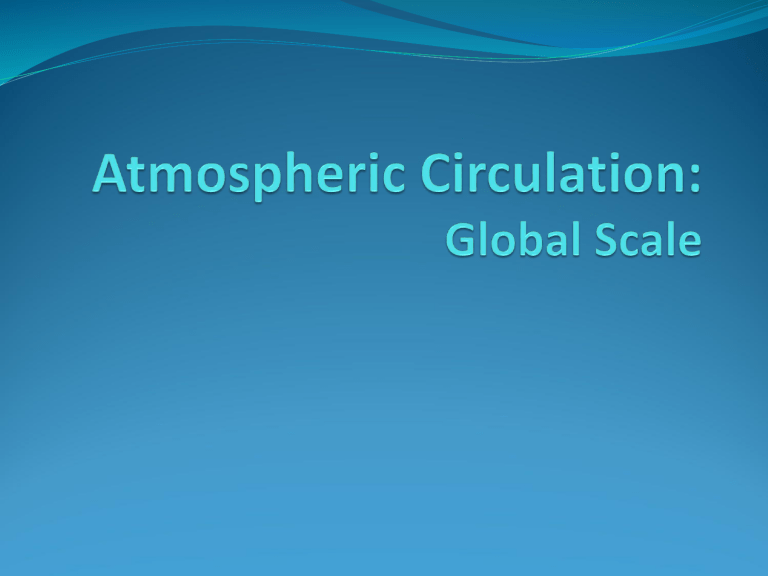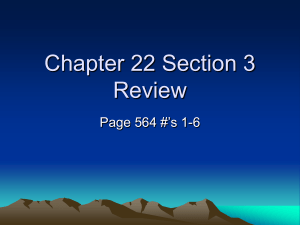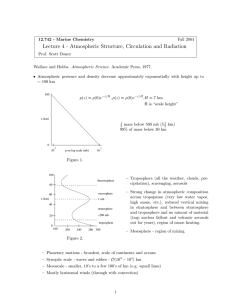
Scale of Atmospheric Motion • Microscale: meters • Turbulent eddies • Formed by mechanical disturbance or convection • Lifetimes of minutes. • Mesoscale: km’s to 100’s of km’s. • Local winds and circulations • Land and sea breezes, mountain and valley winds, thunderstorms, tornadoes. • Lifetimes of minutes to hours • Synoptic scale: 1000’s of km’s 100’s to • Circulations around high and low pressure systems. Eg: Monsoon • Lifetimes of days to weeks. • Global scale: systems ranging over entire globe Scale of Motion Atmospheric Wind System • The circulations of air are driven by differential solar heating. • Tropics receive much more solar radiation than Poles because of • • • Different in the sun`s angle Tilting of the earth’s axis Local reflectivity of the surface • Uneven heating creates high and low pressure zones. • Low pressure zone • High temperature. • High water vapor content (humid). • Atm pressure decreases • Air becomes less dense • High pressure zone • • • • Low temperature. Low water vapor content (dry). Atm. pressure increases Air becomes more dense. Global air pressure due to uneven heating • High surface pressure in cold high latitudes • Low surface pressure in warm low latitudes • Recall that air moves from high pressure to low pressure areas • Surface winds blow from north and south to equator • Upper winds blow from equator to north and south A single cell atmospheric circulation • Proposed by George Hadley (1735) • Assumes that • Earth`s surface is only covered by water • Sun always over equator • Earth does not rotate However earth does rotate !!! The real global circulation from satellite images So a single cell model does not represent the real atmospheric circulation of our earth 3-cell model of atmospheric circulation Polar cell Ferrel cell Ferrel cell Polar cell • Proposed by William Ferrel (1865) • Divided into 3 cells in each hemisphere • Hadley cell (0-30o N/S) o N/S) • Ferrel cell (30-60 Hadley • Polar cell (60-90o N/S) cell 3-cell model of atmospheric circulation Hadley cell • Air rises near equator & descends at 30o N/S • Rising air produces a band of cloud along the equator known as Intertropical convergence zone (ITCZ) • Sinking air produces a major desert along 30o latitudes known as subtropical highs • Surface winds blow from 30o N to equator & deflected to the right: NE trade winds • Surface winds blow from 30o S to equator & deflected to the left: SE trade winds 3-cell model of atmospheric circulation Ferrel cell • Air rises near 60o N/S & descends at 30o N/S • Rising air along 60o N/S known as sub-polar lows • Sinking air along 30o N/S known as sub-tropical highs • Surface winds blow from 60o to 30o & deflected to the right (N) and left (S): westerly trade winds 3-cell model of atmospheric circulation Polar cell • Air rises near 60o N/S & descends at 90o N/S • Rising air along 60o N/S known as sub-polar lows • Sinking air at 90o N/S known as polar highs • Surface winds blow from 60o to 90o & deflected to the right (N) and left (S): easterly trade winds The Real Global Circulation • The Coriolis force, continents, mountains, and ice fields alters the general circulation. • Greater heating over Equator causes air to rise and sink in subtropical regions (30 oN/S). • The circulation will develop: • A semi low-pressure belt that travels northward and southward. • A semi high pressure belt when air descends (becomes compressed and denser) in subtropical regions (30 oS/N latitude) • The descending subtropical air spreads along earth’s surface both back towards: • Equator (trade winds – 0o to 30o S/N). • Higher latitudes/subpolar (westerly wind belts 30o to 60 oS/N. • The rising westerlies air (from subpolar – semi low pressure belt) spreads along earth’s surface both flow towards: • Polar (polar easterly wind belts - 60o to 90o S/N) and to • Subtropical (semi high pressure belt - 30o to 60o S/N). • Semi-permanent Highs and Lows persist throughout large periods of the year. • Winter - highs form over land; lows over oceans. • Summer - highs form over oceans; lows over land. • The Inter-tropical Convergence Zone (ITCZ) shifts toward south in January and toward north in July ITCZ (DOLDRUMS) World Deserts (along ± 30o latitudes) Winter Summer Precipitation pattern Global wind pattern and the Oceans






